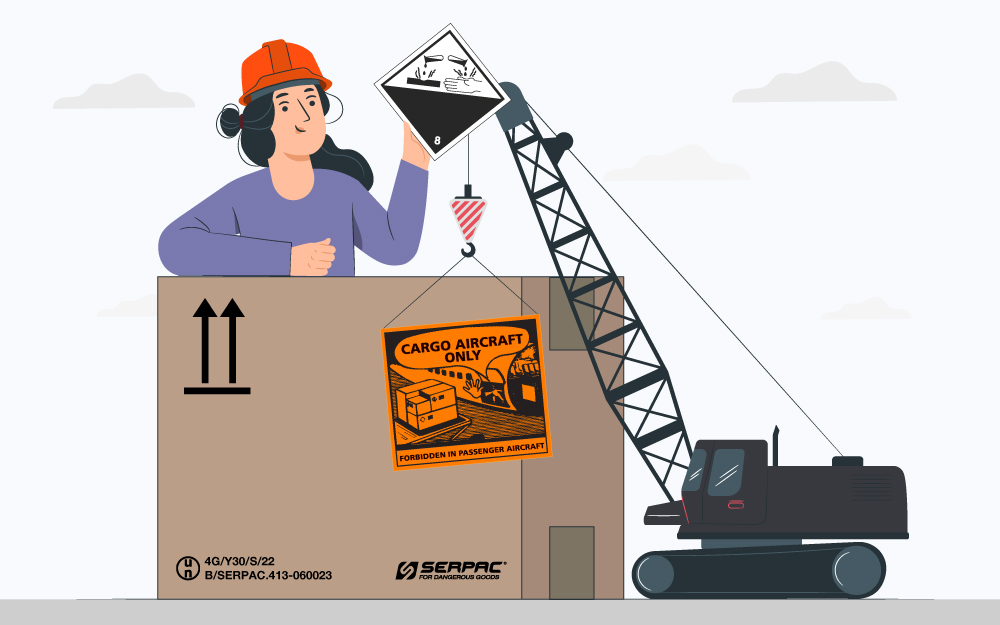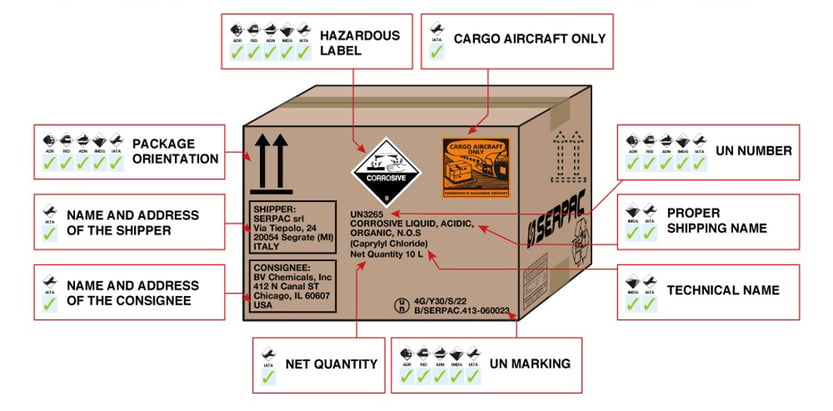How and where to apply dangerous goods marks and labels?

One must follow very precise rules to label and correctly mark packages for the shipment of dangerous goods: using the right labels and marks applied randomly is equal to a lack of labelling.
It is accurate to say that every piece of information must stay in place, it just can’t stay away from “its neighbours”.
We will try to give a clear and concise explanation of how to label and mark a package and which pieces of information must be placed on the same surface, meaning on the same side of the package.
Let’s not focus on the choice of the UN-certified packaging for the moment, and let’s concentrate on how to label and mark packages, taking as an example a 4G UN-certified box and a fully regulated shipment.
As we discussed previously more than once on our blog, one of the first steps to take when shipping dangerous goods in a safe a compliant way is to understand which transportation mode is the most adequate to our needs so that we can refer to the related manual and set of norms: ADR, to transport by road; RID to transport by railroad; IMDG to ship by sea; ADN, by inland waterways and, finally, ICAO-TI e IATA to transport by air.
The details that must appear on a package may vary according to the manual one must consult, and it is, therefore, fundamental to start from understanding which kind of delivery modality is more suitable for your goods, to know which are the requirements we must respond to for what concerns labels and marks.
Also, it is always necessary to know the UN number of the goods we want to deliver, so we can read and correctly interpret the dangerous goods table in the manual we need to use.
Dangerous goods labels and marks
Generally speaking, and without referring to any specific case, labels and marks for a fully regulated shipment of dangerous goods should be displayed as we show here:

We have gathered all the fundamental details that, with just a few exceptions listed on the specific manual, should appear on the package, when ready to ship. We have also indicated if the specific detail is compulsory for the chosen transport modality.
| ADR | RID | ADN | IMDG | ICAO-TI / IATA | |
|---|---|---|---|---|---|
| UN number | V | V | V | V | V |
| Proper Shipping Name (PSN) | X | X | X | V | V |
| Technical name* | X | X | X | V | V |
| Net quantity* | X | X | X | X | V |
| UN certification | V | V | V | V | V |
| Danger label/labels | V | V | V | V | V |
| Handling labels | X | X | X | X | V |
| Orientation harrows* | V | V | V | V | V |
| Shipper address | X | X | X | X | V |
| Consignee address | X | X | X | X | V |
* Required only in some specific cases indicated on the Regulations
Positioning, dimensions, and orientation
Generally speaking, “every label” should be placed on the same surface of the package together with all the other necessary details for the delivery. Labels and marks must be placed on the package so that they are not covered or obscured by any part or attachment to the packaging or any other label or marks. The chart we present here sums up the requirements of all different regulations about which details may or must be placed on the same surface of the package.
| Homologation mark |
UN number |
PSN and technical name |
Net Quantity |
Labels and EHS mark |
Handling label |
Double arrows |
Shipper and consignee | |
|---|---|---|---|---|---|---|---|---|
| Homologation mark |
A | A | A | A | A | A | A | A |
| UN number |
A | B | B | B | B | B | A | C |
| PSN and technical name |
A | B | B | B | B | B | A | C |
| Net Quantity |
A | B | B | B | B | B | A | C |
| Labels and EHS mark |
A | B | B | B | B | B | A | C |
| Handling label |
A | B | B | B | B | B | A | C |
| Double arrows |
A | A | A | A | A | A | D | A |
| Shipper and consignee | A | B | B | B | B | B | A | - |
A: They must not necessarily appear on the same surface of the package
B: They must necessarily appear on the same surface of the package
C: They must necessarily appear on the same surface of the package if the space is enough
D: They must necessarily appear on two opposite sides of the package
Once we have defined which details must stay close to each other, we can analyse the dimensions required by regulations.
It is important to remember that, generally speaking, all relevant details for a safe and compliant shipment must be placed or printed so that they are easily visible, readable, and resistant in all the different steps of the shipment of dangerous goods.
Let’s proceed with order, defining first the required dimensions:
- UN-certification mark
According to the different capacity of packages, the UN-certification mark must be at least:
- Capacity bigger than 30 L or 30 Kg: Minimum height 12 mm.
- Capacity between 5 and 30 L or Kg: Minimum height 6 mm.
- Capacity less than or equal to 5 L or 5 Kg: Adequate dimensions. - UN number
Even for “UN” letters followed by UN number, dimensions specified at point 1 must be respected. - PSN and technical name
There is no specification about minimum dimensions.
One must keep in mind that this information must be well visible and easy to read. - Net Quantity
There is no specification about minimum dimensions.
One must keep in mind that this information must be well visible and easy to read. -
Danger label
Minimum dimensions to respect are very precisely indicated.
For dangerous goods labels, minimum dimensions are 100x100 mm and they must be in the form of a square set at an angle of 45° (diamond-shaped).
Only in the case of ADR, RID, ADN e IMDG-regulated deliveries, if the package requires so, these labels can be reduced up to 50x50 mm.
In the case of IATA-regulated shipments, only a few models of labels can be reduced according to Chapter 7.2.2.3.1 IATA.
Otherwise, it is possible to apply the label without rotating it at 45°, thus in a square-like position.
It is important to remember that in case of a shipment by air, the package must be large enough to contain correctly all the details required. - Environmentally hazardous substance mark (EHS mark)
Minimum dimensions are 100x100 mm and it must be in the form of a square set at an angle of 45° (diamond-shaped). The minimum width of the line forming the diamond shall be 2 mm.
If the size of the package requires so, the dimensions and or the line thickness may be reduced, provided the mark remains clearly visible. - Handling labels
IATA regulations define the minimum dimensions of every handling label.
Some models may have their dimensions reduced in some cases, for instance in the case of CAO labels, orientating arrows, etc. (7.2.2.3.1 IATA). - Double arrows or orientation arrows
Depicting a rectangular border around the arrows is optional, minimum dimensions of reference can be taken from 7.4.5 IATA (74x105 mm). They may be either black or red on white or on a suitable contrasting background. If the dimensions of the package require so, and just in some specific cases, the dimensions of arrows can be reduced up to half of the regular dimension (37x52,5 mm).
- Shipper and consignee
There is no specification about minimum dimensions.
One must keep in mind that this information must be well visible and easy to read.
Labels and marks: issues and solutions.
It is now obvious: details to add and requirements to comply with are so many, that it is easy to get it wrong or to make mistakes. To avoid the most common mistakes and to receive assistance in the most delicate phase when choosing the right marks and labels, it is always necessary to rely on an expert to “understand how to do it and do it better”.
We help our customers to find the best solution in compliance with the law, and to choose among all the labels available in our warehouse. Other than this, we can also help you understand if your package is big enough to contain all required labels and marks, above all for shipments by air.
Contact Serpac, your specialized and trusted supplier!